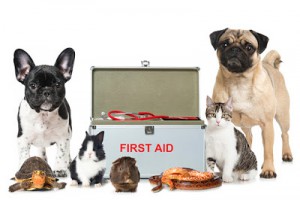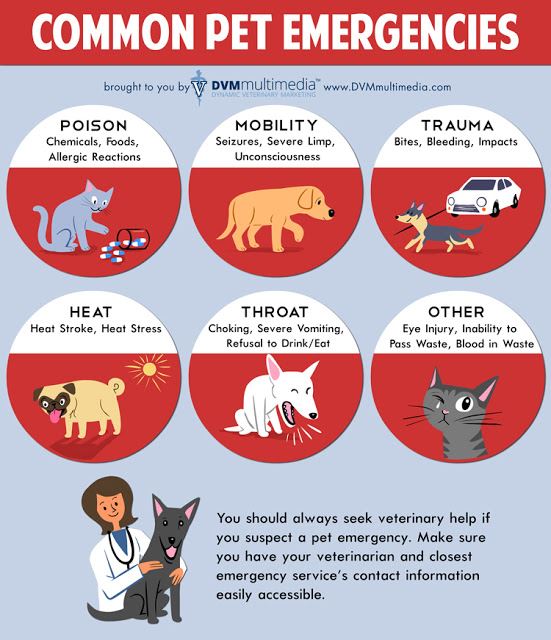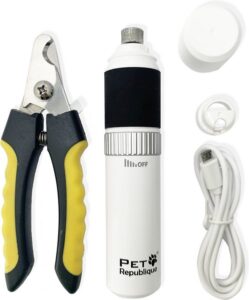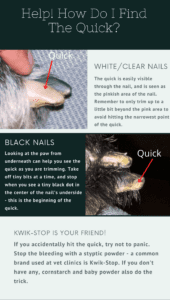What would you do if
…your dog ate the bag of semi-sweet chocolate chips that was left out on the table?
…your cat had a seizure right in front of you?
…your dog fell down the stairs and started limping?
…your cat got into a fight and was bleeding?
I know from personal experience that cats and dogs (and other pets, too) can get into trouble at the drop of a hat and it can be really scary to see them in distress! So, what can you do to help your pet immediately while getting them ready to go to the veterinarian or emergency hospital? Just like with humans, there are a couple of steps to take.

1 – Assess the situation. What has happened to your pet? Are they bleeding, limping, falling over, vomiting, having trouble breathing, crying? Once you know the symptoms, you can look to the next step.
2 – Determine what you can do for your pet. Is there a towel nearby or a first aid kit? Is there someone else in the house who can help you or can you lift your dog by yourself? Will your pet be able to walk on its own to the car? Determine what you can do immediately to give your pet the best chance of making it safely to the veterinarian’s office or emergency facility.
3 – Apply first aid if necessary. This can be the scary part. We here at the animal hospital know that when your pet is hurt, they are also scared and may not react well to being restrained or cared for. Animals may bite, thrash around, run, cry, scratch, or refuse to be touched. Your pet can also pick up on your fear and anxiety, which may make the situation worse. Calmly and gently, get a hold of your pet and apply first aid, preferably with the help of another person. Remember to keep away from the pet’s mouth and face, and keep your motions slow and calm to prevent alarm.
– IF YOUR PET IS BLEEDING: Apply a towel or bandage to the site and apply direct pressure for at least 3 minutes to stop the bleeding. Add towels on top of previous layers if they are soaking through, but do not remove them as it may disturb any clot formation. For heavy bleeding or severe injuries, get your animal to a veterinarian immediately.
– IF YOUR PET IS INJURED: If possible and safe, try to stabilize injuries before moving an injured animal by splinting or bandaging them. *Keep in mind, however, that a poorly applied bandage or splint can do more harm than good; if in doubt, leave the bandaging/splinting to professionals. If there is a foreign body in the wound, do not remove it. If necessary, carefully cut it short without moving it to leave 3-6 inches sticking out before transporting your pet to the veterinarian. While transporting your injured pet, keep him/her confined to prevent further injury.
– IF YOUR PET IS BURNED: Apply a muzzle to your pet’s snout/face and flush the burn with cool (not cold) water. Do NOT apply ointments or medications to the burn, as these may agitate the burn further. Seek immediate veterinary care.
– IF YOUR PET HAS HEATSTROKE: If you cannot immediately get your pet to a veterinarian, move him/her to a shaded area and out of direct sunlight. Get a rectal temperature with a non-mercury thermometer if possible to determine your pet’s temperature (if it’s over 108, seek emergency care immediately). Place a cool, wet towel around your pet’s neck and head (do not cover your pet’s eyes, nose or mouth). Remove the towel, wring it out, then re-wet and rewrap it every few minutes. Use a hose or faucet or bucket to keep cool water running over the animal’s body (especially the abdomen and between the hind legs). Then, use your hands to sweep the water away as it absorbs the body heat. Transport the pet to a veterinarian as soon as possible.
– IF YOUR PET IS BITTEN BY A SNAKE: Assume the snake is poisonous and seek veterinary attention immediately. Try to identify the snake if it can be done without risk; do not attempt to capture or kill the snake. Do not bring the snake into the veterinarian’s office – a photograph will do.
– IF YOUR PET IS POISONED/INGESTED A TOXIC SUBSTANCE: If you know or suspect your pet has consumed something that may be harmful, call your veterinarian, emergency veterinary clinic or the Animal Poison Control Center (888-426-4435 – available 365 days/year, 24 hours/day; a consultation fee applies) immediately. If possible, have the following information available: Species, breed, age, sex, weight and number of animals involved; Symptoms, Name/description of the substance that is in question, the amount the animal was exposed to, and how long it’s been since your pet ate it or was exposed to it. Also have the product container/packaging available for reference. Collect any material your pet may have vomited or chewed, and place it in a plastic sealable bag to take with you when you bring your animal in for veterinary treatment. **Do not try to induce vomiting or give any medication to your pet unless directed to do so by Poison Control or your veterinarian.**
– IF YOUR PET IS HAVING SEIZURES: Clear the area of other pets, furniture, and any other objects that may cause injury. Do not try to restrain your pet or startle him/her out of the seizure. Time the seizure (they usually last 2-3 minutes, but can be as short as 30 seconds). After the seizure has stopped, keep your pet warm and quiet and contact your veterinarian.

And there are a few more that are a bit scarier than the previous emergency situations. These require taking quick action and remaining calm. If you do not feel you can apply first aid, go to your veterinarian or the emergency center immediately.
– IF YOUR PET IS CHOKING: Choking pets have difficulty breathing, paw excessively at their mouths, make choking sounds when breathing or coughing, and may have blue-tinged lips or tongue. If your pet can still breathe, keep him/her calm and seek immediate veterinary care. Look into your pet’s mouth to see if a foreign object is visible. If you see an object, gently try to remove it with pliers or tweezers, but be careful not to push the object further down the throat. If it’s not easy to reach, do not try to remove it – get your pet to a veterinarian immediately. If your pet collapses, place both hands on the side of your pet’s rib cage and apply firm quick pressure, or lay your pet on his/her side and strike the rib cage firmly with the palm of your hand 3-4 times to sharply push air out of their lungs and push the object out from behind. Repeat this until the object is dislodged or until you arrive at the veterinarian’s office. **However, we highly recommend letting a veterinary professional take this course of action.**
– IF YOUR PET IS NOT BREATHING: Open your pet’s airway by gently grasping its tongue and pulling it forward (out of the mouth) until it is flat. Check the throat to see if there are any foreign objects blocking the airway. Perform rescue breathing by holding your pet’s mouth closed with your hands and breathing directly into its nose until you see the chest expand. Once the chest expands, continue administering one rescue breath every 4-5 seconds.
– IF YOUR PET HAS NO HEARTBEAT: **Do not begin chest compressions until you’ve secured an airway and started rescue breathing.** Gently lay your pet on its right side on a firm surface. The heart is located on the left side in the lower half of the chest, just behind the elbow of the front left leg. Place one hand underneath the pet’s chest for support and the other hand over the heart.
• For dogs, press down with quick, firm pressure to depress the chest one inch for medium-sized dogs. Use more force for larger animals and less force for smaller animals. For cats and other small pets, cradle your hand around the animal’s chest so your thumb is on the left side of the chest and your fingers are on the right side of the chest, and compress the chest by squeezing it between your thumb and fingers.
• Press down 80-120 times per minute for larger animals and 100-150 times per minute for smaller ones (less than 25 lbs). Alternate the chest compressions with the rescue breaths: perform chest compressions for 4-5 seconds and stop long enough to give one rescue breath.
• Continue until you can hear a heartbeat and your pet is breathing regularly, or you have arrived at the veterinary clinic and they can take over the resuscitation attempts.
• Please refer to this infographic of pet CPR for visual reference if it’s easier for you – Saving Your Pet with CPR
Always remember that any first aid administered to your pet should be followed by immediate veterinary care. First aid care is not a substitute for veterinary care, but it may save your pet’s life until it receives veterinary treatment.
I hope you don’t have to use these first aid methods any time soon, but it is very good information to know! As the Boyscouts say, “Be Prepared!” I know that I am much better off living at the hospital because all my minions know exactly what to do in case of an emergency situation! I hope that this information will help you be better prepared for applying first aid to your pets in case of an emergency, too.
Til next meow,
Mason

